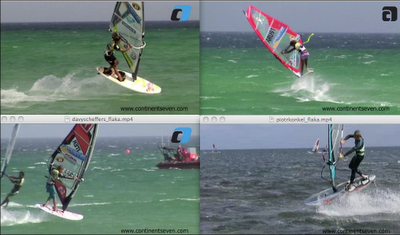One move I'd like to try during the next 2 months is the Flaka. Some windsurfers have a hard time learning the Flaka, but others think it's easier to learn than the Vulcan. A few things that I find attractive about it are:
- I've seen Flaka being completed after a tiny little 45-90 degree jump.
- Compared to the Vulcan, there's a lot less to do - the hands remain on the boom the entire time.
- The Flaka is a natural progression from the upwind 360s, which can be learned in light wind and then practiced in high wind. The only things to add are the initial jump, and the slide.
However, I have one big problem with the Flaka theory: I do not believe the explanation that my favorite windsurfing teacher gives about the mechanics of the move. I think his "quadrant" theories are great for the spin loop and the Vulcan. However, if my memory serves me right, he also thinks that the initial sail throw for the Flaka is into the forward-leeward quadrant, and that mast base pressure makes the board turn upwind.
I looked at the Tricktionary videos, and at least 15 other videos of Flakas in many variations - regular, one-handed, air flakas, and double flakas (mostly at continentseven.com). In all of the videos I looked at, the initial sail throw is to the windward side, typical into the forward quadrant. Here are screen shots from 4 of these videos:
The videos are showing Daida Moreno, Sarah-Quita Offringa, Davy Scheffers, and Piotr Konkel just as the boards are about to leave the water. In each case, the mast is tilted to the windward side, not to the leeward side. The mast remains there while the board is starting to turn, and the nose is coming down:
Note that between the first and second pictures, the boards have turned about 45-90 degrees. This turn cannot be caused by mast base pressure - any mast base pressure would turn the board the other way, away from the wind. Instead, what appears to be causing the board rotation is the "unwinding" of the body, from the shoulder down to the hips and eventually to the feet:
In the third series of pictures, the boards have rotated 180 degrees, and the back legs that were bent in the middle picture are straight again. Now, backwinded sail steering is taking over to push the nose of the board around the rest of the way.
Here's an animated picture series from Daida's Flaka, where the initial oversheeting to (a) depower the sail, and (b) pre-wind the body, can be seen nicely. After the oversheet, watch her body twist the other way, from the hands down to the hips and finally the feet:
So, according to this analysis, the Flaka is a two-part move: in the first part, the board is turned by twisting the body, with the sail basically being neutral; in the second part, the board is steered around the rest of the turn with backwinded sail pressure. This switch, together with the considerable commitment required for the first part, may explain why the Flaka can be hard to learn (especially if you have not done your light-wind homework :).



